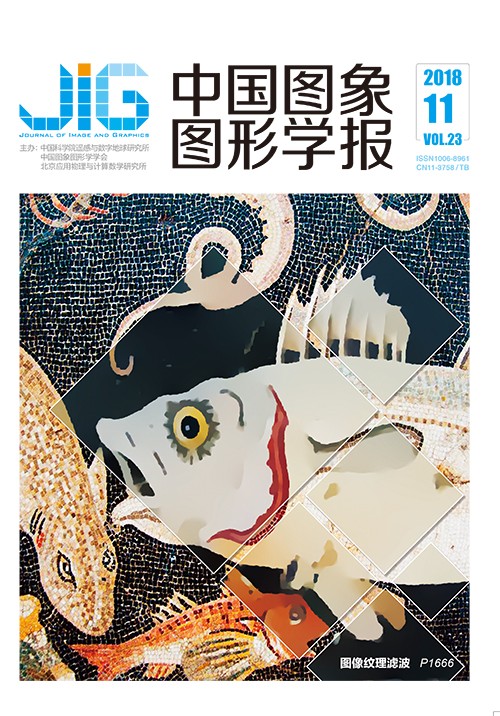
渐进迭代逼近方法在曲线变形上的应用
摘 要
目的 随着几何造型、计算机动画等领域的快速发展,曲线的自由变形技术在近年来受到了广泛的关注。为了获得更多有趣、逼真的变形效果,提出基于渐进迭代逼近与主顶点方法的曲线局部变形算法。方法 给定数据点集,首先采用渐进迭代逼近方法或是基于最小二乘的渐进迭代逼近方法产生待变形曲线;其次对待变形区域使用延拓准则,基于主顶点方法与待变形曲线的形状信息选取控制顶点进行调整;最后对调整后的控制顶点运用局部渐进迭代逼近方法生成逼近曲线,得到期望的变形效果。结果 此变形操作借助于局部渐进迭代逼近方法,具有较好的灵活性。通过茶壶、面部轮廓、手等数值实例,表明了该方法可以得到良好的变形效果。进一步地,借助于叠加变形还可以得到整体的、周期的、伸缩的等各类更加丰富的变形效果。结论 本文研究渐进迭代逼近在曲线变形上的应用,将主顶点方法引入曲线的变形之中,把两者相结合提出了基于渐进迭代逼近与主顶点方法的曲线局部变形算法。该算法不仅具备渐进迭代逼近方法的收敛稳定性,且借助于主顶点方法,可以得到较好的变形效果。该方法适用于曲线的局部变形,丰富了曲线的变形效果。
关键词
Application of the progressive iterative approximation method to curve deformations
Zhang Shijie, Zhang Li, Yu Liping, Liu Wenzhen(School of Mathematics, Hefei University of Technology, Hefei 230009, China) Abstract
Objective :Freeform deformation techniques of curves and surfaces have received considerable attention recently with the rapid development of geometric modeling and computer animation. A new local deformation algorithm for curves based on progressive iterative approximation (PIA) and dominant point methods is proposed in this study to acquire interesting and lifelike deformation effects. The new deformation method not only produces various deformation effects but also possesses desirable properties, such as flexibility and convergence, given the PIA method. Method First, the initial deformation curves are obtained using the PIA or least squares PIA method. Second, the dominant points, which include the maximum local curvature points, and two end points are selected from the initial control points by calculating and comparing the curvatures that correspond to the control points. In this phase, we detect the maximum local curvature points using the rule that the curvature of a point must be larger than the curvatures of its neighboring points. Thus, the maximum local curvature points can be selected as the dominant points. Then, an extension rule is constructed on the region expected to be deformed. That is, we extend this region along the curve until it satisfies the two closest dominant points after selecting the region for deformation in accordance with real requirements. Thus, we can obtain a segment that is bounded by two dominant points. We classify the situation into two categories using the abovementioned extension rule on the basis of the number of dominant points in the obtained segment. The control points, which will be adjusted subsequently, are selected in accordance with the dominant points and the shape information of the curves. If the region that is prepared for deformation contains a dominant point, then three dominant points in the segment will be obtained after applying such extension rule. The dominant point in the middle is selected for subsequent adjustment. If the region that is prepared for deformation does not contain any dominant point, then only two dominant points in the segment will be obtained after extension. We select a control point in accordance with the shape information of the curve, which is useful in handling several complex deformation problems. In this situation, we first calculate the shape parameter for each control point in the obtained segment. The shape parameter represents the complexity of the curve and indicates the difference between two adjacent segments. Second, the control point that has the smallest shape parameter is selected for subsequent adjustment after comparing these parameters. We call this procedure the dominant point method. Moreover, if more than one dominant point in the region is expected to be deformed, then we can split the segment in accordance with the distribution of dominant points to ensure that each segment contains less than one dominant point. Then, we can use the abovementioned dominant point method to select the control points. Finally, local progressive iterative approximation (LPIA) method is adopted to generate the final curves after local deformation. Result The proposed deformation method selects the control points on the basis of the complexity of the shapes of the curves. The deformation method is convergent, can be executed flexibly, and can highlight the features of the deformed regions through local iteration because we use the LPIA method to fit the data set after adjustment. Numerical examples, such as teapot, face contour, and hand, show that the proposed method can obtain favorable deformation effects through the B-spline basis, which is the most commonly used basis in geometric design and exhibits excellent local properties. Specifically, the teapot mouth is stretched by adjusting the selected control point. The lips, eyebrows, and earlobes of the face contour are deformed by using the deformation algorithm to generate a fascinating face. The fingers are also stretched to make the hand natural. We also demonstrate the distortion, which occurs when we do not use the deformation method proposed in this study, as illustrated in the teapot example. We can clearly observe that, if we do not adjust the control points generated by the algorithm, then the curve after deformation will be distorted and lack reality. Furthermore, this algorithm can be used repeatedly to generate the global, local, periodic, and elastic deformation effects. Conclusion This study mainly focuses on applying the PIA method to the local curve deformations. First, we discuss the PIA method, which presents an intuitive and straightforward approach to fitting data points and provides flexibility for shape control in data fitting. Second, we introduce the notion of dominant points into the curve deformations. Finally, we propose a new deformation method on the basis of the PIA and dominant point methods by combining the two techniques. The algorithm not only possesses the properties of convergence and stability through the PIA method but also produces various positive deformation effects by selecting dominant points. A user must only select the regions expected to be deformed during the implementation of the deformation method and determine the deformation scales in accordance with his/her requirements, thus guaranteeing the interactivity of this algorithm. In summary, the proposed method significantly enriches the deformation effects of curves.
Keywords
progressive iterative approximation curve deformation local curvature deformation effect computer aided design
|



 中国图象图形学报 │ 京ICP备05080539号-4 │ 本系统由
中国图象图形学报 │ 京ICP备05080539号-4 │ 本系统由